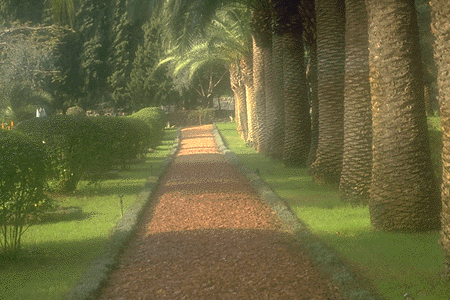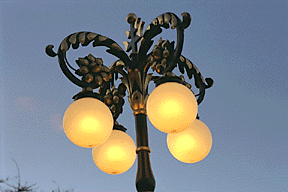Bahá'í Aesthetics of the Sacred

Date palms lining the path by the Eastern Pilgrim House next to
the Shrine of the Báb
It has been suggested by Robert Stockman, Coordinator of the Research
Office of the Bahá'í National Center in Wilmette, Illinois, that
Bahá'í Holy Places have three characteristics:
light,
greenery, and the presence of
objets d'art.[29]
In many of his writings, Bahá'u'lláh uses light as a metaphor to indicate
spiritual illumination. Greenery and gardens are suggestive of
spiritual life.
Gardens are also reminiscent of Eden. Works of art
are pleasing to the eye and serve to beautify the sites.

Lamp in garden near the Shrine of the Báb
The Shrine of Bahá'u'lláh and the Shrine of the Báb are well
illuminated by lamps and windows, and are surrounded by gardens.
There are trees in the interior of the Shrine of Bahá'u'lláh.
This is very different from the aesthetics of medieval
cathedrals, for example.
It has been suggested that the
gardens almost form an integral part of the Bahá'í shrines.[30]
In this resepct, the
Bahá'í gardens in the Holy Land are possibly unique among
religious sites. The interior of the Shrine of the Báb is decorated
with Persian carpets,
menorahs, and illuminated texts from Bahá'í scripture.
Examples of objets d'art found in other sites
include Chinese art, and statuary.
Next: Conclusion
Up: Bahá'í Holy Places
Previous: Haifa
G.M. Viswanathan
| Up to the Bahá'í Home Page


